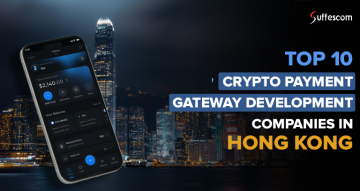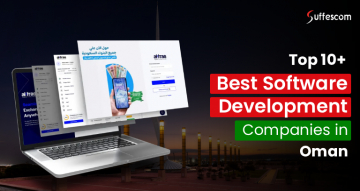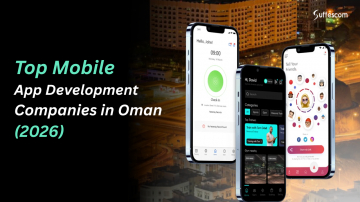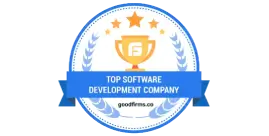How To Create Carbon Trading Exchange Software? Complete Guide

In the past twenty years, climate-related disasters have increased by 83%, from 3,656 to 6,681 events. This doesn't look right! It points towards a not-so-prosperous habitat. CARBON, a byproduct of various industrial and development practices and a major contributor to climate change needs extensive regulation.
Each problem has a solution, and technology is of the utmost importance in balancing the carbon present in the environment. The technological advancement that we are talking about is carbon trading software development.
With changing times and an increase in adverse climatic situations, the world is inclining towards carbon credit trading applications. If you are wondering how? Here’s a fact!
Market research indicates the global market of carbon credit trading platforms was valued at approximately USD 131.40 million in 2024 and is expected to grow to USD 632.10 million by 2034, with a CAGR of 17.01% from 2025 to 2034.
Carbon credit trading solutions simplify credit trading to reduce greenhouse gas emissions. Carbon credits and carbon offsets are two primary components of such decarbonization software development solutions.
Carbon credits are like a permit that grants businesses, governments, or individuals the right to emit one ton of carbon dioxide (CO2) or an equivalent greenhouse gas. Carbon offsetting is the simplest way to balance out the carbon emissions created by an entity. It is like you are paying for a project that reduces or removes equal CO2 somewhere else.
We will delve deeper into this exciting and promising technological advancement. If you are a startup, an established commercial organization, an individual, or any governmental entity looking to leverage the potential of a carbon exchange platform. Then this blog is for you.
Read till the end for complete understanding and learn how you can contribute to a fresh and green tomorrow!
Carbon Credit Exchange Platforms for Sustainability Goals!
Our carbon trading software development services accelerate your sustainability goals. Schedule a free demo today and discover how easy it is to achieve compliance and profit.
What is Carbon Credit Trading Platform?
In simpler terms, carbon credit trading platforms are online marketplaces that help users trade carbon credits, like stocks on an app. Such platforms include two of the major parties, as follows;
- Companies or organizations that contribute significantly to pollution require carbon credits to cover their emissions.
- Companies or projects that reduce emissions by conducting initiatives funded by the entities that purchase carbon credits (mentioned in 1st point). Such initiatives include reforestation & afforestation, storing carbon-storing agriculture, waste management, etc.
- The carbon credit exchange platform connects these two parties, letting them buy and sell credits securely.
- The goal is to encourage less pollution by making it cheaper to reduce emissions than to buy credits.
Carbon credit trading marketplaces are built on blockchain networks, delivering decentralization, security, and accessibility. The platform makes trading fair, transparent, and efficient, often using blockchain for secure tracking.
How Blockchain Enhances the Capabilities of Carbon Markets?
The carbon market faces inefficiencies, a lack of transparency, and doubts about the authenticity of carbon credits. Blockchain technology offers a solution with its decentralized ledger system, recording transactions across a network for transparency and security.
This tamper-proof record validates carbon credits, enhancing trust and efficiency in the trading process. In 2024, the voluntary carbon market was valued at $2 billion, with the potential to grow to $1 trillion within 15 years.
By addressing these challenges, blockchain can unlock the full potential of the carbon exchange platform, supporting the urgent need to tackle climate issues through scalable and credible carbon credit projects.
There has been a significant increase in the importance of transparency in carbon credit trading, and blockchain is proving to be a valuable solution. Here's how!
- Improvement in traceability by implementing a smart contract that provides an audit trail of each credit's lifecycle on a carbon credit platform.
- Blockchain prevents double-counting by tokenizing carbon credits, making it impossible to use the same credit twice.
- It streamlines verification and auditing by facilitating the implementation of effective data sharing systems for project developers, verifiers, and auditors.
- Blockchain improves data integrity by implementing immutable systems that minimize the risk of data manipulation and fraud in carbon exchange platforms.
- Blockchain technology enables extensive market access by delivering fractional ownership of carbon credits.
- A smart contract automates the entire lifecycle of carbon credits, encompassing issuance and trading.
Essential Components of Carbon Trading Software Development
The proficiency and functionality of each component will determine whether carbon credit trading performs well in the market. We incorporate all essential and enhancing components into the development process.
1. Functional UI/UX Design
The presence of a functional and appealing UI/UX design is obvious. Such designs make it easier for users to navigate and use the software easily. The simpler and engaging a design is, the higher the assurance of user satisfaction and software adoption.
Which technology helps create better designs? We utilize the industry-oriented front-end tools like React or Angular for building the interface, and design tools like Figma for planning. Our process includes;
- Creating wireframes and prototypes
- Designing as per user feedback
- Testing prototypes
- Refining and reiterating as per usability
The exclusion of a foundational UI/UX design would result in the loss of a potential user base, leading to business loss.
2. User Registration and Authentication
To let the users stick to your platform for a longer period, ensuring seamless user registration and authentication is crucial. What benefits would there be if users cannot easily register on the carbon credit exchange platform?
Efficient user registration and authentication systems are crucial for protecting sensitive data, such as financial transactions and emission records, from unauthorized access.
Avoidance of secure systems increases the risks of hacks, loss of trust, and potential legal issues. Hence, we utilize secure methods like OAuth for login and databases like PostgreSQL for storing user information for highly secure user registration and authentication systems.
3. Data Security and Management
Being a crucial part of almost every other application type, data needs the utmost attention, especially in carbon exchange platforms. Why? Because carbon trading involves sensitive data, breaches can harm reputation and break laws like the GDPR.
To address this urgency, our team utilizes encrypted databases and access controls, including data encryption, regular security audits, and backup plans. The presence of these systems enables higher user trust and compliance and assures against data leaks, legal fines, and loss of user trust.
4. Integration with Carbon Registries and Emission Trackers
Integration with carbon registries and emission tracking systems is crucial to fulfill the primary purpose of carbon credit trade platforms. Integrations connect the software with systems that verify carbon credits and track emissions, like official registries.
These integrations also ensure the authenticity of carbon credits and the accuracy of emissions, which reduces fraud. Being complacent in ensuring this integration leads to heavy business losses due to the circulation of fake credits and market distrust.
5. Reporting and Analytics
Reporting and analytics tools facilitate carbon exchange platforms for efficient and informed decision-making by providing access to trading activities, emissions, and market trends. It helps users understand their performance and comply with legal regulations.
To impart the same benefits, we provide easy-to-understand and visually appealing reports using tools such as D3.js and Crystal Reports. It enables users to track progress, meet reporting requirements, and plan more effectively.
While the requirement of analytics and reporting tools might seem non-essential, without them, users lack insights, struggle with compliance, and make poor decisions.
6. Regulatory Compliance
Nobody wants legal penalties, potential shutdowns, and reputational loss, which might all occur in the absence of regulatory compliance systems. Regulatory compliance reduces risks and increases user trust by confirming the platform's legality and ethicality.
How do we impart regulatory compliance in developing an air carbon exchange marketplace? Firstly, we include compliance modules and audit trails for tracking. Secondly, we involve automatic checks, audits, and reporting to regulators for the development process.
7. Third-Party API Integrations
Third-party API integrations improve the software's functionality by adding useful features and improving the user experience. Using APIs like RESTful allows the carbon credit trading solution to connect with other services such as payment processes, crypto wallets, news portal for market updates.
Avoiding such integration limits the app’s features, making it less competitive and complex to use. To ensure that it does not happen with your carbon credit trading application, we implement efficient practices for documenting, testing, and maintaining these integrations.
Step-by-Step Carbon Trading Software Development Process
What are the ingredients of a professional and reliable carbon exchange marketplace development? Comprehensive market research, meticulous planning, agile development, robust testing, and constant customer support. Suffescom delivers them all. Let's explore!
Step No.1 - Market Research
Market research sets a foundational path for the end-to-end development process. Market research includes-
- Analyzing market size and growth
- Identifying target users
- Competitor analysis
- Regulatory landscape
- Understanding trends
Why is market research necessary? It aligns the platform with market demands to increase adoption, identifies revenue opportunities, and sets a clear app development roadmap. Engaging with stakeholders to gather user insights is one of the most effective market research practices.
What are the results of poor market research? Firstly, it would result in an app with misaligned features, non-fulfilment of regulations, and the possibility of legal issues. Here's how we tackle these pitfalls?
- Using industry reports and government data for accurate insights.
- Conducting primary research (surveys or interviews) with potent
- ial users to understand needs using Google Analytics.
- Competitor analysis to differentiate the air carbon exchange marketplace platform.
Step No.2 - Creating a Development Strategy
This step involves defining a technical and strategic approach, including;
- Researching carbon credit standards and types: Understanding standards like Verified Carbon Standard (VCS), Gold Standard, and Clean Development Mechanism (CDM), and types like nature-based or clean energy credits (Verra VCS).
- Analyzing blockchain platforms: Evaluating platforms like Ethereum, Polkadot, or BNB Chain for security, scalability, and smart contract development support.
- Identifying the exemplary blockchain development service.
Creating a development strategy provides various benefits such as compatibility with multiple credit types, helps choose a scalable and secure blockchain, and partners with promising vendors to minimize development risks.
As a reliable carbon trading software development company, we research and adhere to standards that support a diverse range of credits, ensuring market relevance. Also, we compare blockchain platforms based on transaction speed, cost, and community support.
Avoiding due attention to create a development strategy could result in limited credit support and blockchain scalability issues.
Step No.3 - UI/UX Design
UI/UX design needs no compromise as it is the first user expression of an application. The design must be intuitive, including seamless navigation, appealing visualizations, and responsive design to;
- Improve user satisfaction and retention
- Reduce errors
- Increase carbon trading efficiency
- Enhance accessibility
The major loss of avoiding UI/UX design is the loss of a potential user base and implementing best design practices by;
- Employing experienced UI/UX designers for the carbon exchange marketplace development.
- Conducting user research to tailor the design to the needs of carbon traders.
- Creating wireframes and prototypes using Figma or Sketch, and conducting usability testing with InVision or Lighthouse.
- Ensuring compliance with accessibility standards, such as the Web Content Accessibility Guidelines (WCAG).
- Use prototyping tools for iterative feedback.
- Test with diverse user groups.
Step No.4 - Technical Development
This step includes three major components-
Tokenization and Smart Contract Development
Both tokenization and smart contract development are the backbone of a carbon credit trade platform. Any blockchain-based application does not function without these two.
- Standardized token implementation: Creating tokens for carbon credits.
- Smart contract development and verification: Writing and auditing contracts for credit issuance, trading, and retirement.
- Decentralized Data Persistence: Storing data on the blockchain for transparency.
Performing this step enables secure and transparent trading, automates processes, reduces costs, and improves user trust for carbon exchange platforms. To deliver the same benefits, we implement the best practices, such as using established token standards, conducting smart contract audits, and ensuring registry integration for authenticity.
Frontend and User Interaction Layer
This step includes-
- Setting transparent data visualization systems for presenting credit details and market trends.
- Crypto wallet integration using Web3.js.
These provisions simplify user interactions, security, and trust, provided that best practices such as using wallet libraries, user training, and interface testing are implemented.
Backend Infrastructure and System Architecture
Developing backend infrastructure and system architecture increases reliability, security, and supports high transaction volumes. Doing so safeguards against downtime, poor integrations, and loose operations.
- Backend infrastructure and system architecture include;
- Threat modelling for identifying and mitigating security risks.
- Performant system design for ensuring scalability and low latency.
API integration for connecting with registries, payment gateways, and other systems.
Our professionals use the following best practices to achieve the most outstanding results;
- Following OWASP security guidelines.
- Use cloud-native architectures.
- Design modular APIs.
Step No.5 - MVP Development and Launch
MVP development and launch help optimize the carbon credit trading platform as per the user insights and drive higher user adoption. The team focuses on regulatory compliance, data analytics and content marketing.
If you are wondering what some of the best practices are for ensuring a satisfactory app launch? The list includes;
- Staying updated on regulations.
- Using robust analytics platforms.
- Tailoring content to user segments.
Usually, ongoing customer support and app maintenance follow app launch and deployment.
Carbon offsetting Exchange Marketplace Development
Leverage our turnkey carbon exchange marketplace development services to launch a secure, scalable trading hub. Connect now and get your personalized quote!
Carbon Exchange Marketplace Development Cost
It costs between $20,000 and $50,000 to develop a leading carbon credit exchange platform. The following table will help understand the carbon credit platform development cost in detail.
| Component | Cost Range | Description |
| Market Research, Business Analysis & Planning | $2,000 – $5,000 | Requirement gathering, platform flow design, and regulatory alignment |
| UI/UX Design | $2,000 – $4,000 | Wireframing, prototyping, user interface, and user journey mapping |
| Frontend Development | $4,000 – $8,000 | Client-side development (React.js, Angular, etc.) |
| Backend Development | $5,000 – $10,000 | Server-side logic, API development, database management |
| Blockchain Integration | $3,000 – $7,000 | Smart contract development, carbon credit tokenization (optional but common) |
| Payment Gateway Integration | $1,000 – $3,000 | Integration of fiat/crypto payment processors |
| Admin Panel Development | $2,000 – $4,000 | Platform management dashboard for admins and auditors |
| Security Implementation | $1,000 – $2,000 | Data encryption, secure APIs, compliance (GDPR, etc.) |
| Testing and Quality Assurance | $2,000 – $4,000 | Manual testing, automated testing, performance testing |
| Deployment & Launch | $1,000 – $2,000 | Final server setup, cloud hosting (AWS, Azure), launch activities |
| Post-Launch Support & Maintenance | $1,000 – $3,000 | Bug fixes, updates, security patches (first 3-6 months) |
However, there are several factors that affect the cost range of carbon exchange marketplace development. These factors are as follows-
Here are the factors that affect the cost of carbon credit trading software development:
- Complexity of features
- Regulatory compliance
- Integration with existing systems
- Security requirements
- Scalability
- User experience design
- Testing and quality assurance
- Technology stack
- Maintenance and support
Conclusion
It is a high and right time to invest in carbon exchange platform development, as the world needs these platforms more than ever now. The market is growing already; investing in developing a credit exchange platform would bring in hefty returns and contribute to environmental conservation.
These blockchain-based carbon credit trading platforms allow organizations or businesses to cover their emissions and fund projects that aim to offset carbon emissions. Invest now, save the environment and get satisfactory returns with best-in-class carbon credit platform development services.
FAQs
1. How much does it cost to develop a market-ready carbon credit exchange platform?
It costs between $20,000 and $50,000 to develop and launch a professional carbon credit trading platform. This cost range includes various components such as market research, business analysis & planning, UI/UX design, frontend development, backend development, blockchain integration, payment gateway integration, admin panel development, security implementation, testing and quality assurance, deployment & launch, and post-launch support & maintenance.
2. How blockchain improve the functionality of carbon exchange platforms?
Blockchain in a carbon credit exchange platform improves traceability, prevents double-counting of carbon credits, streamlines verification and auditing, improves data integrity, and automates the complete life cycle of carbon credits.
3. What are the key components of carbon exchange marketplace development?
The key components of carbon trading software development include real-time carbon credit trading, emissions tracking and reporting, regulatory compliance tools, secure transaction processing, integration with environmental data sources, and user-friendly dashboards for market insights.








